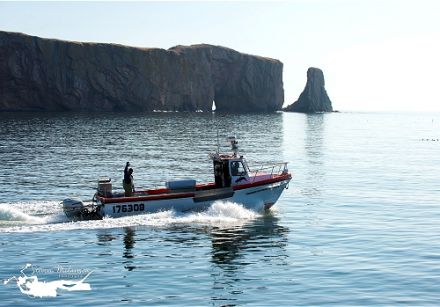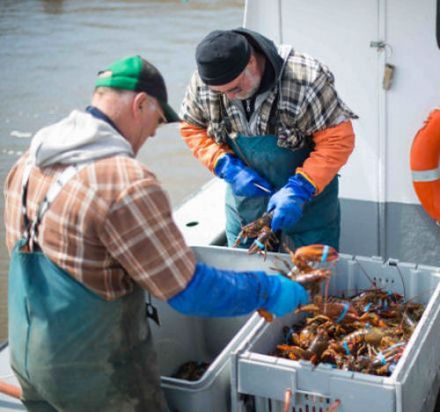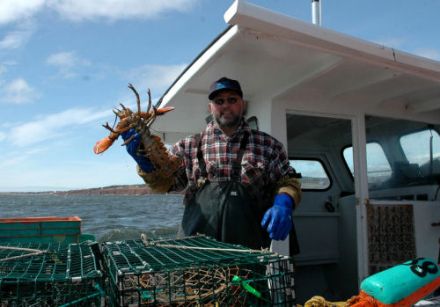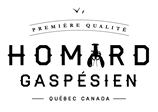 |
All about lobster > Gaspé Peninsula lobster, the most highly recommended in the world
The Gaspé lobster is practically perfect, as confirmed by the Marine Stewardship Council's (MSC) ecocertification. Only 252 groups of fishermen around the world have been granted this ecocertification. And when it comes to fishing, with all resources combined, it takes in the entire world.
This is the only lobster in the world whose journey can be traced back from your plate to the lobster fisherman, in addition to being certified by the MSC. It's the only lobster that meets numerous strict sustainable fishing criteria and bears a medallion telling you which fisherman captured it.

133 fishing boats set sail last Sunday at 4:30 AM. “It was ideal weather for the start of the season” commented Jean Côté. “It was a windless morning; the sea was calm. This is what we need to make a safe exit to put out their lobster cages. It was between -5 and -6°C, relatively mild weather for the season to make the departure even more pleasant.” During the 68 days, the authorized duration of fishing, millions of lobsters will be caught (1) according to the rules of responsible fishing.
Lobster fished by members of the Professional Fishermen's Association of Southern Gaspésie is tastier, because it comes from the rocky seabeds and cold clear waters of the northern gulf of St. Lawrence. Gaspé peninsula lobster molts only once a year (late summer), meaning that when it is caught, it has a hard shell full of firm, tender, delicious white flesh. Weighing more than a pound (500 g), it is a gourmet delight. Even better, we know they'll be around a long time, because they're protected, raised and stocked. The responsibility then falls to the consumer to cook them well and prepare them so they're absolutely perfect!

SEA-TO-FORK TRACEABILITY
Since 2012, every lobster harvested around the Gaspé Peninsula bears a blue rubber band and tag on one of its claws. The tag will allow consumers to see exactly where the crustacean came from, ensuring them that they’re buying a superior quality product from the Gaspé Peninsula, harvested in a manner kind to the environment.
By visiting the website and entering the alphanumerical code stamped on the blue tag attached to their lobster, consumers can watch a video clip about the harvester who caught their lobster, learn more about his fishing area, see the name of the lobster boat’s skipper and the method used to catch the lobster. It’s a unique way to bring consumers and their seafood harvesters closer together!
This new season marks the 14th anniversary of the identification of 100% of the lobsters caught in the Gaspé Peninsula, a traceability approach that is still unique in the world,
At the market
Ah, the nuances of language... Some grocers will swear that the lobsters in their tank come from Gaspésie, and technically they're right. The industrial companies that sell them are set up in Gaspésie, but they buy their lobsters in the Maritimes and mix all the lobsters together. So though they may COME from Gaspésie, they're not CAUGHT in Gaspésie. There's a big difference.
So to find the real thing, be sure that the lobster bears a tracing tag. It guarantees that it was fished solely in Gaspésie.

Fill a pot about quarter full with fresh water* and bring to a boil.
Add sea salt; about ½ cup salt for each 3.8 l (one gallon) of fresh water.
Cut the elastics from the lobster with a pair of scissors or a kitchen knife.
Drop the lobster into the boiling water and cover. Bring to a boil.
Simmer for 15 (male) to 18 minutes (female) per pound. Note: Cooking times are different for male and female lobster. To check whether the lobster’s ready, just pull on an antenna. If it comes out easily, the lobster’s done to perfection!
When the lobster’s cooked, taken it out of the pan and put it in a bowl of salted ice water (30g / 1 oz salt for each one l (one gallon) of fresh water) for 5 minutes.
Serve and enjoy.
* Some people prefer to use seawater to cook their lobster. In this case, follow the same cooking method but don’t add any sea salt.
How can you tell the difference between male and female lobster?
Batiste's 6 tips to savour your lobster to perfection
Reserve your lobster. Everybody has a crush on this crustacean!

A sustainable fishery
The Regroupement des pêcheurs professionnels du sud de la Gaspésie works actively to make sure the lobster fishery develops in a sustainable manner. The Gaspé Peninsula’s lobster harvesters have for many years adopted various management and control measures to foster the protection of their resource while reducing the fishing effort; notably it has:
- Increased the minimum catch size (from 76 mm in 1996 to 82,5 mm in 2018);
- Established a maximum size (150 mm), thus keeping catch size within a strictly limited range;
- Reduced the number of traps (250 to 235) and commercial lobster harvesting licence holders (by 30%) by introducing a licence buy-out program for Regroupement members to reduce overfishing
- Introduced a trap model (2011) that prevents any increase in fishing capacity.
Today, the Regroupement acts proactively; its actions seek to enhance lobster reproduction, protect biodiversity and improve habitats to ensure the sustainability of this fishery. To this end,
- It requires members to have escape hatches on their traps so small lobster can escape before the traps are hauled every day.
The environment is changing, but the sustainable fishing measures that have been in place for a long time in Gaspésie are still improving to ensure that there are good lobster year after year.

It's Jean Côté, a biologist and the scientific director of the Professional Fishers Group of Southern Gaspésie who is the proud "father" of 1,75M lobsters. It is under his responsibility that nearly 250,000 baby lobsters are released to the sea each year in order to compensate for 3-5% of lobster catches thus ensuring their continuance.
To learn more about Aquahive, an innovative nursery system, click here.
Resource-wise, the picture is bright, points out biologist Jean Côté of the Southern Gaspé Professional Fishermen Group. According to scientific observations, climate change appears to be causing lobster populations to move northward, from the United States to our homeland. "We went from a northern climate to a preferential climate and that’s good for us”.
2023 was a record year with 8.6 million lobsters caught, totaling more than 4,800 tonnes of lobster caught. We expect, if not to break the record, at least to come close. All conditions are on our side.

(1) The minimum catch size has been increased from 82 mm to 82.55 mm and the maximum size decreased to 150 mm (the size of the lobster is that of the cephalothorax, from the hollow of the eye to the end of the thoracic carapace and not the tip of the tail at the end of the nose). It may seem like very small differences, but it will allow to relocate about 225,000 lobsters that would otherwise have been caught.
Photos: Professional Fishers Group of Southern Gaspésie

-

 Recipes
Recipes
-

 Products
Products
-

 Entertaining
Entertaining
-

 Chefs
Chefs
-

 Hints & Tips
Hints & Tips
-

 Glossaries
Glossaries








